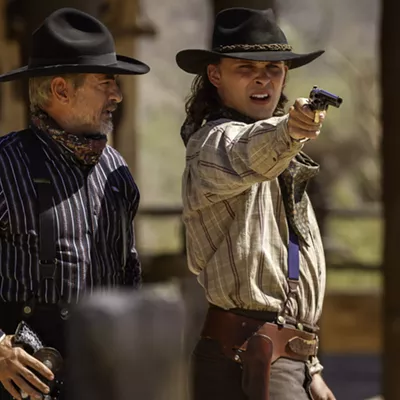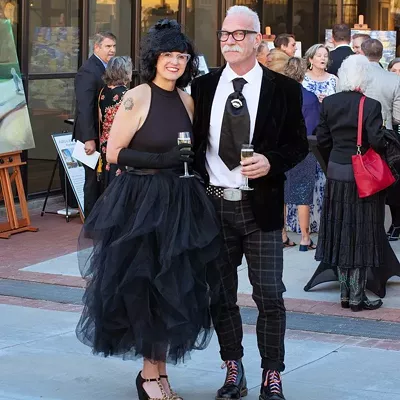By the time he was 23 years old, Alex Webb felt like he had hit a wall in photography.
A wunderkind who had already published two photography projects while he was still an undergrad at Harvard, he'd just been offered a slot in the prestigious Magnum photo agency. He was winning praise for his bleak black-and-white photos of the degraded American cityscape, New Topographic-style images of strip malls and parking lots. But he was dissatisfied.
"The work wasn't going anywhere," Webb told The Guardian earlier this year. "It wasn't expansive or resonant. So I began casting around for a new direction."
The direction he took was south, to Mexico.
Across the border, he found streets crowded with people, lovers standing under archways, kids playing soccer, women sweeping the dirt, men teetering atop trucks. Bars glowed neon; random holes opened up in roadways; tienda walls were canvases for paintings of boats and eagles. The strong sun, so different from the northern light of Webb's native New England, blazed a hot white, and the shadows were deep black.
Webb's photography was transformed. He returned again and again to Mexico, making some 40 trips over 30 years, from 1975 to 2007, taking many thousands of pictures.
A spectacular array of some 50 of these works cover the walls at Etherton Gallery, in a traveling show aptly called La Calle, the street. (An accompanying mini-show, Carpoolers by Alejandro Cartagena, a skilled color photographer, features ingenious aerial views Mexican riding in the crowded flatbeds of pickup trucks.)
In his first years wandering on the other side of the line, in the '70s, Webb stuck to black and white. Even so, the works teem with visual bounty. "Matamoros, Tamaulipas," from 1978, pictures a lush graveyard carpeted by grassy weeds. Crosses and flowered wreaths are planted on the grave mounds; some stand boldly vertical while others have already toppled to the ground.
Beyond the cemetery is a broken-down shed and a small farmhouse with a peeling roof. On the high horizon, a man rides a galloping horse, a small child clinging to his back. And in the foreground, a young boy, shirtless, stares wonderingly at the photographer.
This elusive work is beautifully composed. Like most of Webb's images, it has strong lines, both diagonals and horizontals, and a sensitivity to tone: the white wreaths pop against the shadowy grass and the sky is a pale and gloomy gray.
It wasn't long before Webb turned to color. How else to capture Kiko's Blue Room, a bar in Nuevo Laredoa, Tamaulipas? A tilting Kiko's sign blazes in hot pink neon against the black night sky; below, the Blue Room walls are intensely turquoise. Out front a woman in a short white dress leans provocatively against a post; behind her, red lights shine through the bars' windows. And in an incongruous touch, so typical of Webb—and of life—the woman whiles away the time reading a book.
The salmon and ochre of Mexico's stucco houses, the bright red of a man's shirt hard by the harsh gray steel of the border wall, the pink flowers on a little girl's dress, the orange glow of nighttime streets: Webb beautifully renders them all in Kodachrome, the legendary color film that's no longer manufactured.
Webb spent a great deal of time along the border—there are shots from Agua Prieta, Naco and Nogales and Tijuana—but he embraced all of Mexico. One of his best-known works, of boys playing soccer in a church plaza, was taken in Tehuantepec in the far southern state of Oaxaca in 1985. It's a brilliant study in blue and white—everything from the church to the boys' clothes is blue or white, and even the soccer ball is blue.
Front and center a boy spins that ball on one finger. Blurred by the movement, the ball has the look of a globe, and the boy the look of a titan who holds the great world in his hand.
Webb has a gift for capturing the "decisive moment"—the term coined by photographic eminence Cartier-Bresson to describe the split-second when everything a photographer sees aligns. A few seconds later in Webb's soccer picture, the ball might have fallen out of the boy's hand. In the black-and-white graveyard, that ambiguous horse and its riders might have trotted right out of the scene.
The "decisive moment" isn't just the product of artistic genius. It's achieved mostly by long hours of patient waiting and watching, and shooting plenty of images. Webb told the Weekly some years ago, in conjunction with a show of his border photos, that he would typically shoot 1500 to 2000 rolls of film in a year, and "come away with maybe 15 pictures."
Much has changed in Mexico over the years since Webb began working there, as he acknowledges in an essay in the companion book. Drug violence—murders, torture, kidnappings—have scarred the nation, and Mexico's borders, both north and south, are the scenes of migrant tragedies on a biblical scale. You can't look at the long-ago photo of the Tamaulipas graveyard without thinking of the Tamaulipas massacre in 2010, when 72 Central American migrants were slaughtered by cartel thugs.
In Chiapas, Webb had photographed migrants who've come over the border from Guatemala—a group of adults huddled in a makeshift outdoor shelter, two men fast asleep on unused railroad tracks and a boy in blue lying next to a train. Most such migrants make the dangerous trip atop la bestia—the beast train—and it's unclear whether the child in blue is dead or alive.
Closer to home, Webb pictures hopeful border crossers cocooned into blankets in the streets of Tijuana. And in a shot from Agua Prieta, the border wall, merging from fog, is a forbidding barrier in metal. But one determined man is breaching it. All we see of him is one leg and one arm. The rest of his body is already on the other side, waiting for one last push to send him into America.











